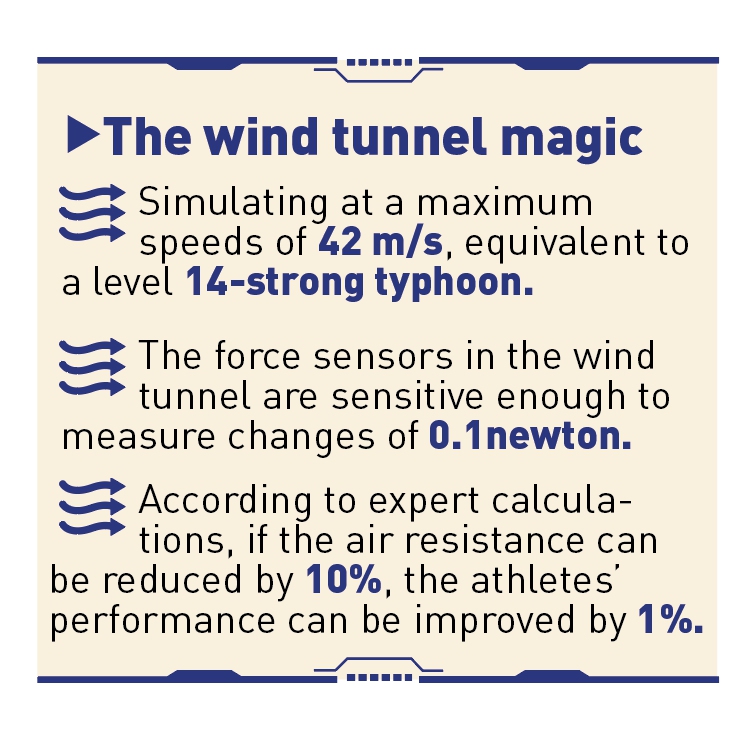How technology helps Chinese athletes make breakthroughs at Beijing Winter Olympics

A ski jumper practices with the help of the wind tunnel training system at Team China's training base in June 2021. Photo: Courtesy of Wang Chongli's team (Graphic: GT)
Modern sports competitions are by no means a one-man event. The technology behind such elite sporting events offers indispensable support.
From the accurate capturing of relevant movement data to help develop and improve training plans, the overall improvement of sports equipment performance, to the worry-free training security guarantee, the power of China's technology plays a significant role in the athletes' pursuit of professional success.
In the past, China lacked professional training sites and techniques for ice and snow sports, and many training teams for ice and snow sports had to be stationed abroad for extended periods, which led to high training costs and limited scientific research guarantees. Currently, China's cutting-edge technology is being applied in a wide array of fields to help the Chinese Winter Olympic delegation make up for any possible shortcomings and weaknesses, and to guarantee safe and satisfactory results, experts told Global Times.
Optimized training tactics
The wind tunnel, a technique that has been widely used in designing missiles, rockets, and aircrafts, has in recent years also been used to advance sports science and training especially in sports like ski jumping.
The newly-formed China ski jumping team, with the help of the homemade wind tunnel training system, has successfully qualified for and performed at the Beijing Winter Olympics.
It was a landmark step for the ski jumping athletes and their support staff. "There was no wind tunnel training equipment for skip jumpers in China until 2019; before that, our athletes had to go abroad for training," recalled winter sports expert Wang Chongli, whose research team later built China's first and currently the world's largest wind tunnel training facilities for ski jumpers.
A wind tunnel training system mainly consists of 4.5-meter high and rectangle-shaped training areas, huge, three-story high heat exchanger parts, and cameras capturing the athletes' movements, Wang elaborated, who is also a sports science and technology research director at the Aerodynamics Research Institute under the Aviation Industry Corporation of China (AVIC).
In the past, it was difficult for ski jumpers to fully understand their performances during the only three or four seconds of them jumping in the air, Wang said. "Now the wind tunnel, by suspending them in mid-air and simulating airflows similar to the winds around, enables the athletes to feel all the details of their movements and make adjustments accordingly," Wang told the Global Times.
The elaborate techniques based on aerodynamics and analysis of human motion help ski jumpers to individually observe and improve every step of the whole process, including jump assistance, take-off, flight, and landing, according to Wang.
"The wind tunnel system can record the six dimensions of forces that ski jumpers experience during the process, such as lift, resistance, and lateral and turning forces," Wang told the Global Times.
The system also offers ski jumpers safer training, Wang added. Since ski jumping is highly affected by nature, bad weather such as heavy wind or snow usually hamper athletes’ training, he mentioned, noting that “with the indoor wind tunnel they can keep training either in snowstorms or hot summers.”
At present, the wind tunnel training equipment is being applied in more sports such as sailing and speed staking, helping team China to explore the perfect positions and techniques to reduce wind resistance.
Although China's application of wind tunnel technology was relatively late, it now has completely surpassed Western countries thanks to the recent rapid development of China's technologies in this area, said Li Yuqiu, a research fellow at the military-civilian integration office of the China Academy of Aerospace Aeronautics (CAAA). "We can say that our overall technology level is already leading the world," Li told the Global Times.

Graphic/GT
In the BSU Erqi National Winter Sports Training and Research Base located in Southwest Beijing's Fengtai district, multiple advanced technological training facilities has helped Chinese athletes made breakthroughs in Beijing 2022.
In the Six-Degree-of-Freedom Oval operated by Beijing Sport University Winter Sports, an anti-dizziness trainers for training pilots are introduced to the sports field to help athletes improve their balance. The simulated training system for skiing and skeleton athletes can collect their training data in real time through high-precision encoder to improve athletes' training effect and race performance in a targeted manner.
The training base's large-sized integrated running platform is also a stunning piece of professional equipment for carrying out physical and technical training for winter sports. The multifunctional running platform can increase the athletes' slalom and giant slalom race rate, speed up the training rhythm, allow athletes to use their ankles and knees more flexibly to improve their core strength and harness explosive power.
Improved logistical support
Skeleton, a relatively unpopular snow sport with a weak foundation in China, impressed Chinese audiences at the ongoing Beijing 2022 Winter Olympics with its intense excitement and, moreover, an unexpected bronze medal won by the relatively young Chinese team.
It was a "corner overtaking" success that Chinese skeleton racers, most of whom were former track and field athletes and had only participated in the 2018 PyeongChang Games before, made a splendid showing this time, backed by a comprehensive support team consisting of sports science and medical specialists, said Gao Binghong, a professor at Shanghai University of Sport (SUS) who's been the head of a 20-member team serving the China skeleton team since 2019.
"Knowing little about skeleton at the beginning, we had to learn everything about the sport from scratch," Gao told the Global Times.
Gao's team, made up of SUS experts in various fields from athletic training and sports technical analysis to rehabilitation medicine, nutrition, and psychology, drew on the expertise of overseas skeleton athletes and gradually developed a set training system for Chinese racers.
The team spent a great deal of time analyzing the capacities that skeleton racers need, and then focused on excising the explosive power of their lower limbs and the coordination of movements of their upper and lower limbs. "We also researched the techniques of how the racers ride and push sled based on kinematics, which are essential to the skeleton competition," he mentioned, noting that "one cannot slide fast without good pushing skills."
Each year the China skeleton team spends months at a ski resort in Northwest China's Shaanxi Province, which is equipped with tracks specially built for the sport. During the rest of the time, they have strength training and rehabilitation at the SUS in Shanghai.
With breakneck speeds of more than 140 kilometers per hour, skeleton is regarded as a very dangerous sport by many. To better protect the racers, the team offers comprehensive rehabilitation that consists of traditional Chinese medicine (TCM) such as massotherapies, acupuncture, and moxibustion.
"It's good to see that few of our skeleton racers were ill or injured [during trainings and competitions]," Gao told the Global Times.
The record bronze medal on the male's skeleton by Yan Wengang at the Beijing 2022 Winter Olympic Games has largely inspired the Chinese squad and its support teams. "For the next couple of years, we will continue serving the racers with better research on the techniques, especially the technique of riding the sled. In this respect there's still much space for us to improve," Gao said.
In addition to the all-round protection in the training process, in the face of accidents that may occur at any time in the competition,Beijing Jiaotong University and Chinese PLA General Hospital jointly developed an intelligent medical system, which collects vital signs in real time and assists on-site medical staff to dynamically assess injuries through an algorithm. This system can identify injuries through evolutionary computational modeling to provide scientific support for emergency medical treatment, which is a historical first
For the injury scenarios, the team developed an intelligent Q&A system based on deep reinforcement learning modeling, in which 45 major injury categories and 3,183 entity data sets were extracted from authoritative literature to build a medical knowledge map.

Graphic/GT
Photos
Related Stories
- U.S. figure skater Karen Chen cherishes Beijing 2022 despite unfavorable result
- China's ice hockey players hope to promote the sport in home country
- Norway wins Nordic combined team gold at Beijing 2022
- 18,000 volunteers serve in Beijing 2022 as ‘heroes behind scenes’
- Athlete from Xinjiang region refutes rumors, shares interesting stories in Olympic Village
Copyright © 2022 People's Daily Online. All Rights Reserved.










